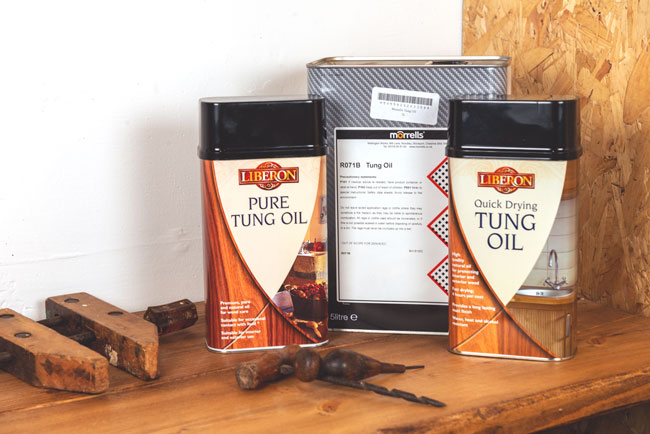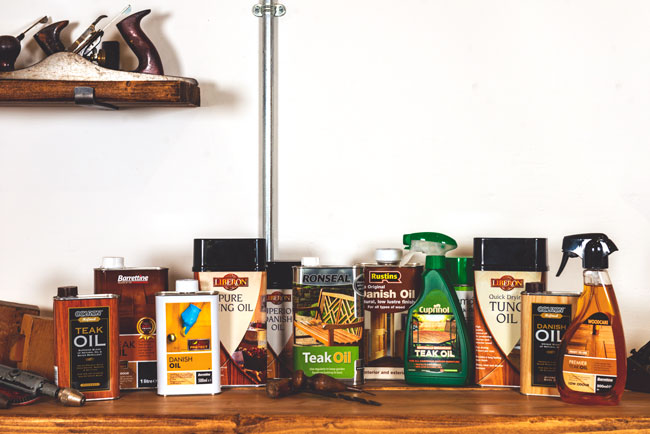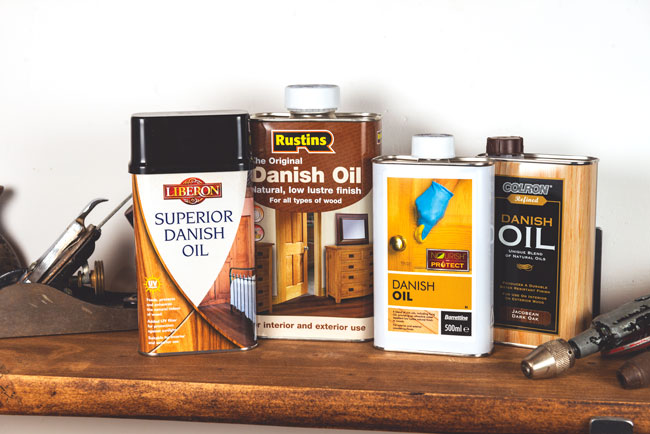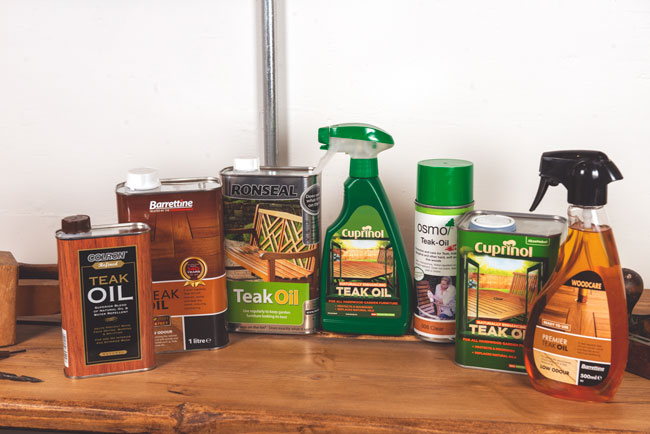Traditional wood oils have been used to preserve and protect wood for thousands of years and to this day, remain as popular as ever. Although modern wood oils come with the promise of better durability, fewer coats, quicker drying times and less maintenance, traditional wood oils are still the ‘go-to’ products for many skilled craftsmen such as carpenters, woodturners, toy, cabinet and furniture makers.
What are wood oils and how do they work?
Wood oils are essentially the natural oils that are extracted from vegetables, plants, trees, nuts and seeds. On a microscopic level, wood is full of holes, not unlike a pack of straws viewed end on. Applying a wood oil fills these holes and in doing so, keeps the wood supple and waterproof. Once exposed to Oxygen, these oils oxidise and harden in the surface of the wood grain to become part of the wood. The finish they provide is dry (non-greasy), and to varying degrees, moisture, stain and dirt resistant.
What are traditional wood oils?
Whilst there are many ‘old school’ wood oils, the most commonly used are without a doubt Danish oil, Teak oil, Tung oil and to a lesser degree Linseed oil. There is no set formula for Teak or Danish oil meaning that they can vary from brand to brand. This sometimes means that an oil from one brand may differ slightly to another giving different drying of finishing characteristics.
For those that use these oils on a regular basis, it’s often a case of trying products from different brands to find the oil that best meets their requirements. This said, most formulas are very similar and a preferred product is usually easily found.
What’s the difference between old and new wood oils?
Whereas traditional oils were blended through experimentation with naturally occurring ingredients, modern wood oils such as ‘hard wax oils’ are scientifically formulated from blends of oils, resins, solvents and chemicals to make them more durable, longer lasting and faster drying. This makes newer oils more suitable for large projects such as flooring and decking where faster drying times, better durability and reduced maintenance are a major consideration. It’s usually carpenters, wood craftsmen, hobbyists and restorers who prefer the slower drying times and the ability to build layers that traditional oils offer.
Danish oil
Danish oils are a bit of an oddity in that although it is widely sold by many manufacturers, there is no defined formulation to its composition. Danish oil is typically made from blends of Linseed oil and/or Tung oil, mineral spirits, synthetic resins and varnish to make it durable and easy to work with. Rustins Danish oil however is considered to be the ‘original’ formula.
Danish oil Uses
Danish oil is a highly versatile oil that is water resistant and food safe. This makes it a popular choice for real wood kitchen worktops, food utensils, wooden tool handles and more. It dries to a hard, satin finish and is very easy to maintain.
The name ‘Danish oil’ simply comes from the fact that during the second half of the 20th Century, Scandinavian furniture, protected with an attractive low sheen finish, began to be exported around the world. This finish was given the name ‘Danish oil’ because of where it came from.
Danish oil Review
Great product & very easy to use
It`s the first time I used Danish oil (recommended by a friend) & was surprised by the quality of the finish. I used it on a kitchen table, & so is subject to various levels of abuse. The table surface is admired by all that see it, & so far is lasting well, despite the rigors of everyday use.
See our full range of Danish Oils here.
Tung oil
Pure Tung oil is extracted from the seed of the tung tree, which is native to China and a few other Asian countries. It is considered to be an environmentally friendly wood finish as it doesn’t contain any other ingredients or manufacturing processes. It is also less known as China wood oil and its use is thought to have originated in China as far back as 400 B.C.
It’s worth noting that whereas some Tung Oils are pure, some brands of ‘tung oil’ do contain additives and other ingredients to assist with application and drying.

Tung oil Uses
Tung oil started out as a popular choice for boat decks and floors but because of its flexible, durable and food safe properties, is now more widely used on a whole host of projects. Because it doesn’t darken and is resistant to mould, it is widely used on interior and outdoor furniture, wooden toys, cabinets and musical instruments such as guitars and more.
Tung oil Reviews
Great product, I would definitely recommend
Used pure Tung oil on bare oak kitchen worktop. It takes a few coats to complete and takes a long time to dry but gives a nice soft sheen finish which doesn’t stain (red wine, curry, hot mugs). Needs re-applying about once a year and does take days to dry properly but after a day or so light use is fine – just keep wiping it over. I have used around the kitchen sink and bathroom sink and no stains.
Teak oil
Teak oil, strange as it may seem, has nothing to do with the Teak Tree. As with Danish oil, it’s made from a blend of ingredients, namely Linseed oil, pure Tung oil, mineral spirits (petroleum naphtha) and varnish. Petroleum naphtha is derived from petroleum and is used as a thinner for the oil. The reason why Teak oil is called ‘Teak oil’ is purely down to giving the product a purpose, namely being suitable for use on Teak wood, such as Teak garden furniture. Formulations can vary from brand to brand based on the quantities and quality of the ingredients used.
Teak oil Uses
The primary use for Teak oil has traditionally been for exterior wood such as outdoor wooden furniture and for wood on boats. Teak oil is designed to slow down the natural greying process of Teak whilst protecting it from weathering. Although Teak oil can be used on most types of softwood and hardwood it is better on hardwoods. The thin nature of the oil means that softwoods that are more porous than hardwoods and contain less natural oil will soak up more of the oil, potentially making it an expensive choice. The use of Teak oil in warm, humid environments can actually promote the growth of mould.
Teak oil Reviews
Easy to apply, quick drying, with superb finish
This Teak oil is easy to apply, and quick to dry, resulting in a superb finish. The teak oil has restored the colour and finish of our gates. Highly recommended!
See our full range of Teak Oils here
Linseed oil
Linseed oil is produced from the pressing of the seeds from the flax plant and has many uses. Also known as Flaxseed oil, Linseed oil in its raw state is also used as a food additive and available in capsules as a food supplement. Although Linseed oil can and is used as a standalone product in its ‘raw’ and ‘boiled’ variations, it is more commonly blended with paints and other wood oils to make other products including Danish oil and Teak oil.
Linseed oil Uses
Most famously used on cricket bats, Linseed oil is more suitable for interior wood. As with most other types of wood oil it enhances, beautifies and restores interior wood. Linseed oil can be more difficult to apply than other types of oil and the ‘raw’ version can take up to a week to dry. Some say that raw Linseed oil never fully dries. The ‘boiled’ version of the oil dries quicker in around 24 hours, enabling projects to be completed faster.
Linseed oil Reviews
Boiled Linseed oil is providing me with a delightful finish to my English oak wood panelling and stairs
It is just what I required and is giving me a product that I can work with to give an excellent finish to my project which is restoring a building first built in 1896. It has suffered much neglect over the years but boiled linseed oil as one of the products I am using is breathing life back into the wood of the building.
So there you have it, whilst modern alternatives such as Hardwax oils, Decking oils, Worktop oils and Door oils are more convenient and formulated for specific projects, there will always be a place for the traditional wood oils that have been around for decades or longer.
For more information about wood oils and their uses, contact our team of resident experts who are always on hand to help with project advice and product recommendations. Alternatively, see our wood oils FAQ page which covers many of the most commonly asked questions about wood oils.
We love to see before, during and after photos of any wood finishing project. If you would like to share your project pictures with us and our followers, send us some photos or share on our Facebook, Twitter, Pinterest or Instagram pages.








I moved to a dry, hot climate. My new wooden dresser is getting cracks on top due to the dryness-what would be the best oil to use on it – it’s Yukas wood
Hi Laura,
Yukas wood is very dense and for that reason you reauire a thinner oil. Please consider this one; https://www.wood-finishes-direct.com/product/osmo-wood-wax-finish-extra-thin
Please come back to me if required – Alison
I have to restore a very old nativity set, the wood is very dry & quite cracked, which oil would you recommend to nourish & restore the wood?
Hi Claire,
Thank you for your enquiry. It really depends on whether the nativity set is going to be interior or exterior. Please contact us with some pictures and we can then recommend the best products for your project.
Hello!
So, i am looking for the best oil based finish in order to darken a wooden bed and give it a more walnut look. (Hope it doesn’t smell after fully dry).
Thank you in advance!
Hi Nikos,
Thank you for your enquiry. Please consider the product below. This is an interior, water-based wood stain and comes in a lovely colour range including Walnut. This product is available in samples and we always recommend test areas.
https://www.wood-finishes-direct.com/product/protek-royal-interior-stain
Hi,
I’m trying to find out which oil is best to apply inside drawers in a dresser. I need something that will not ruin clothes or paper or actually anything that is kept inside the drawers. I’m using tung oil for the outside of the piece, but not sure if it is also good for inside of drawers.
Thank you!
Silvina
Thank you for your enquiry.
Please see the product below that is a solvent free oil. It will completely dry and doesn’t have a strong aroma like traditional solvent based oil;
https://www.wood-finishes-direct.com/product/polyvine-wood-oil
i am trying to find some danish oil that will give me a gloss fish. We had a new kitchen three yrs ago with walnut worktop, it came with two tins of danish oil, it did not have a brand name. When it was applied it was like treacle, I applied three coats and after the third I just buffed it to a shine, this was so good, water resistant could wipe all marks off so we were very pleased.
Now we are refurbishing the worktop and have tried three danish oils, they all dry to a mat finish and mark very easily, can you recommend anything like the original please?
Hi John,
Please consider this Danish Oil by Liberon. This dries to a Satin/Semi Gloss Finish and is the shiniest Danish Oil that we stock. This is a superior oil that also offers UV protection;
https://www.wood-finishes-direct.com/product/liberon-superior-danish-oil